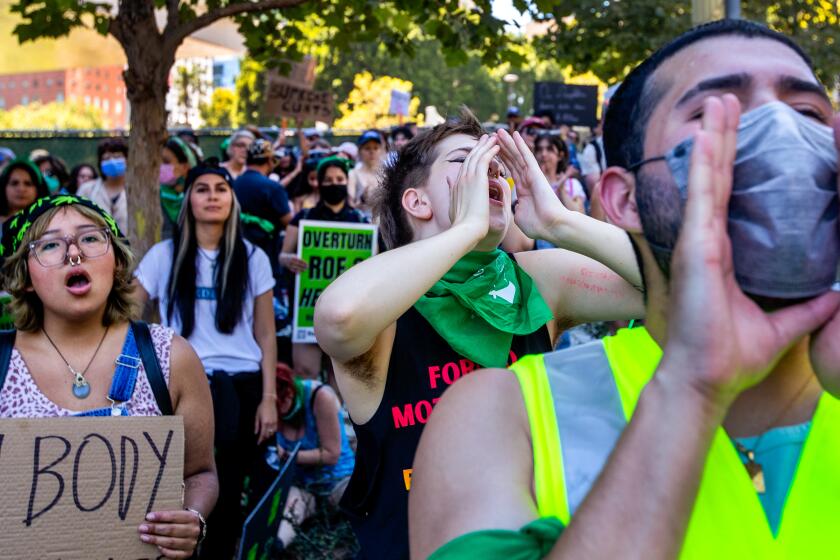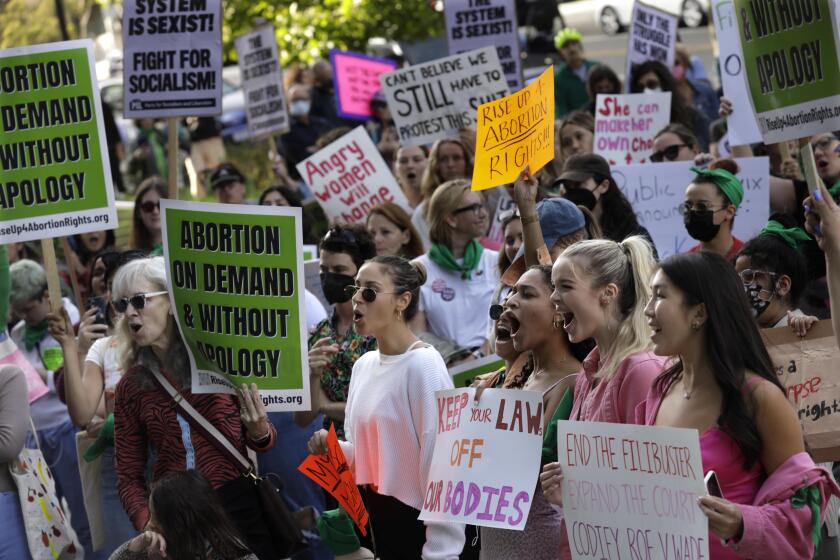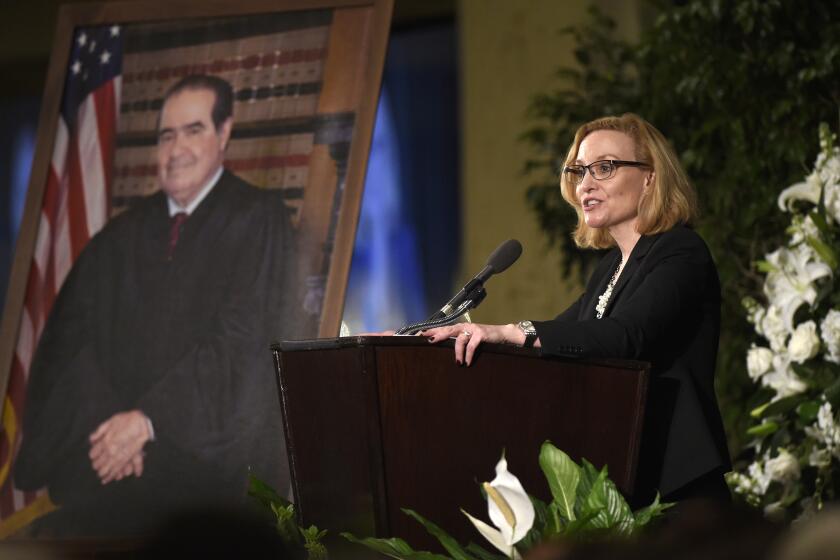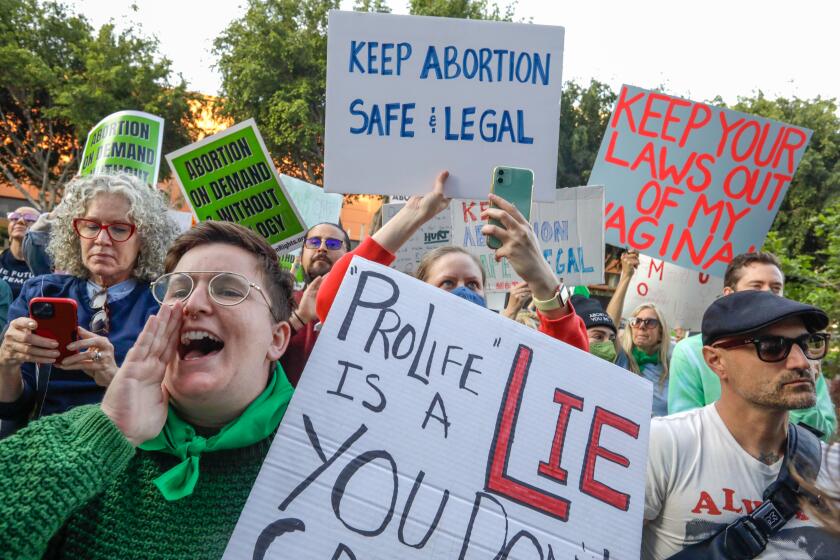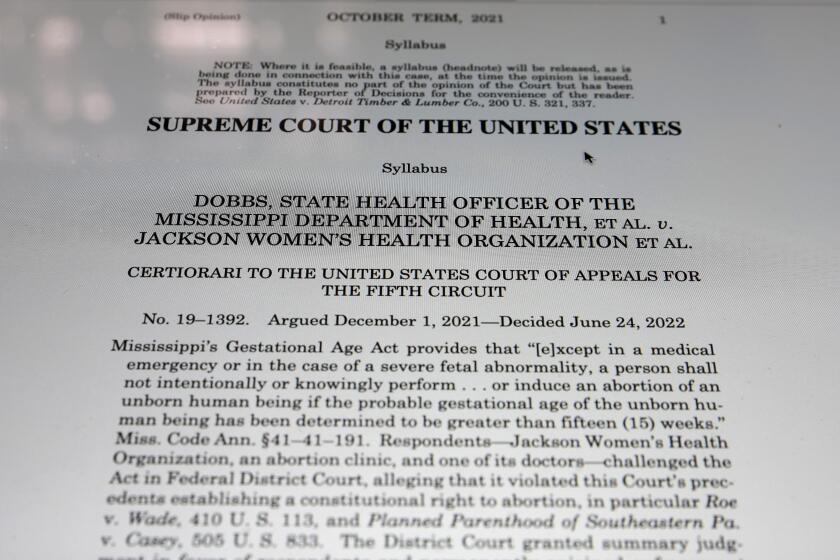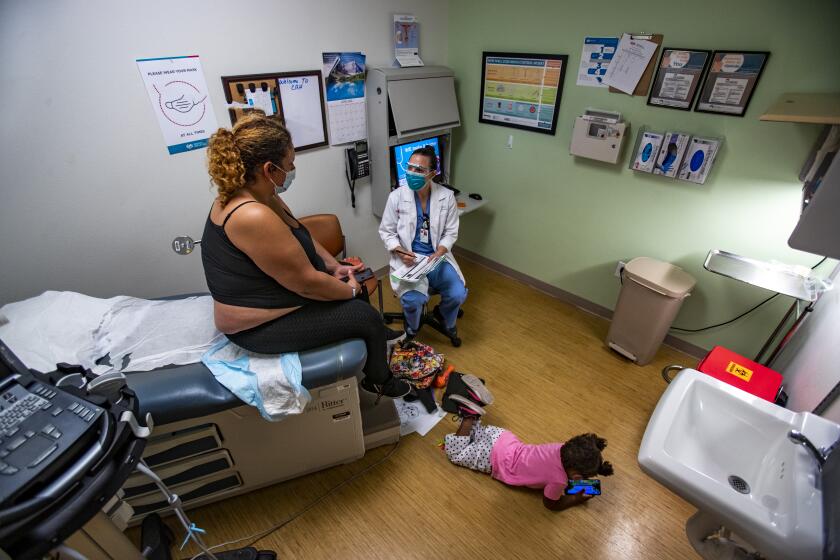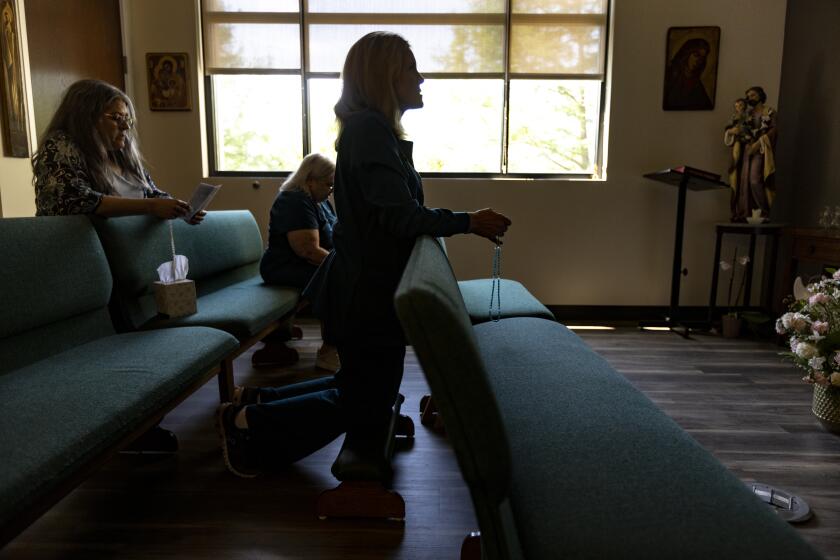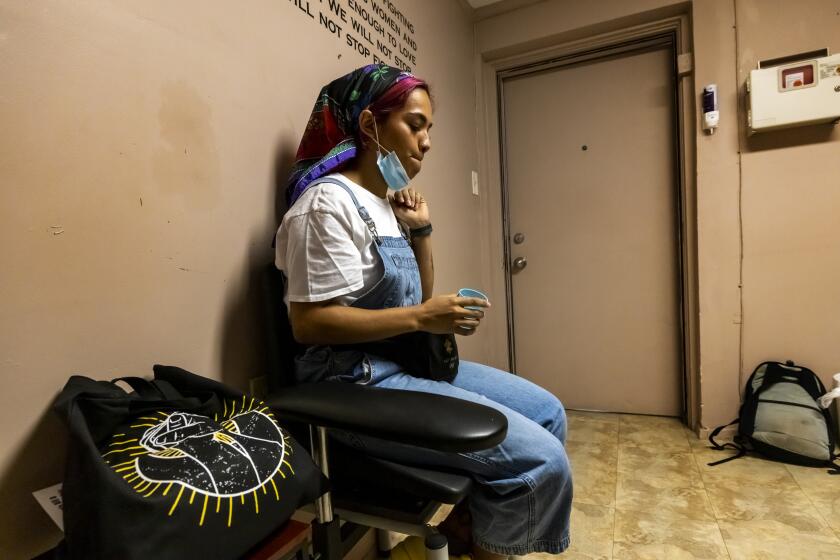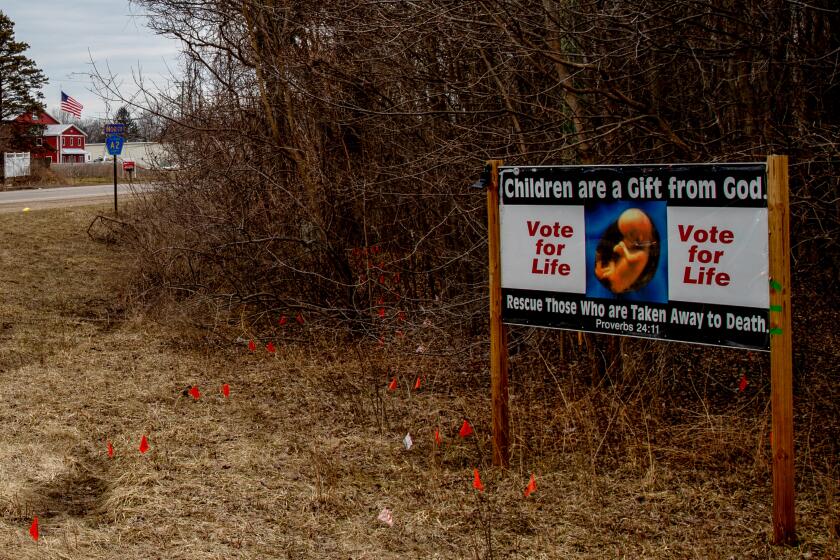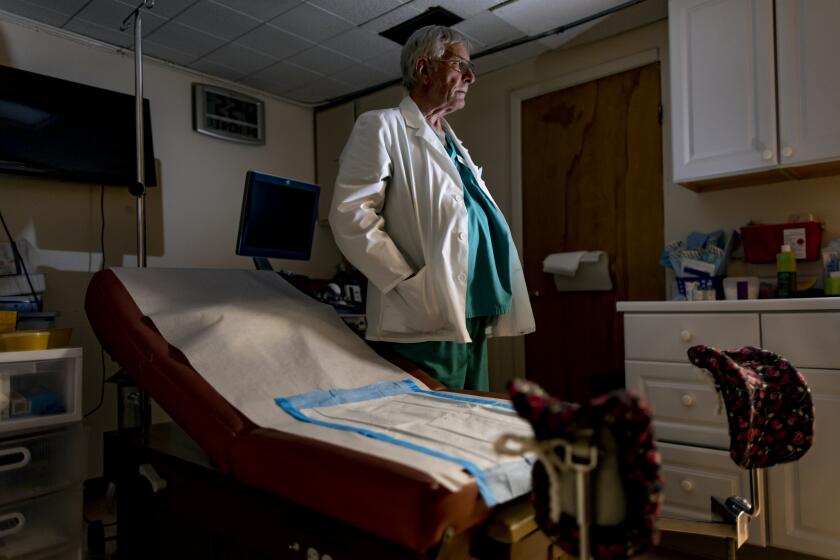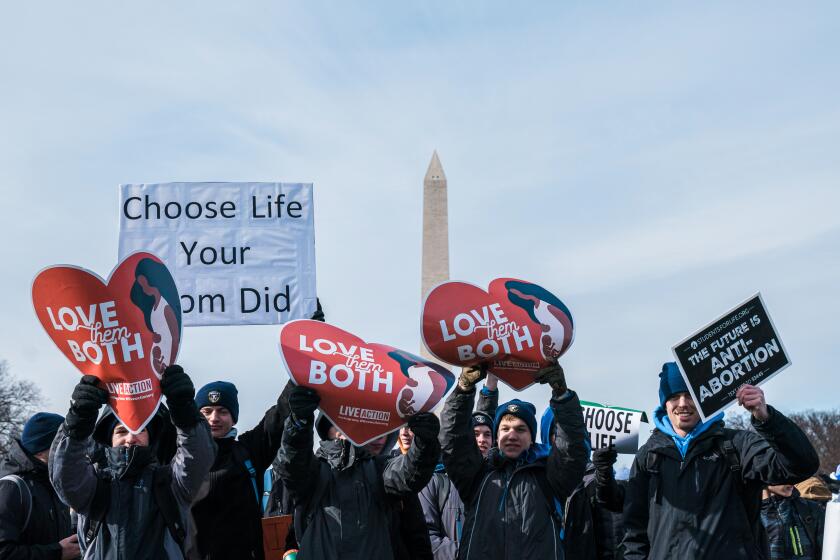Where is abortion legal? In red states, women navigate a chaotic landscape
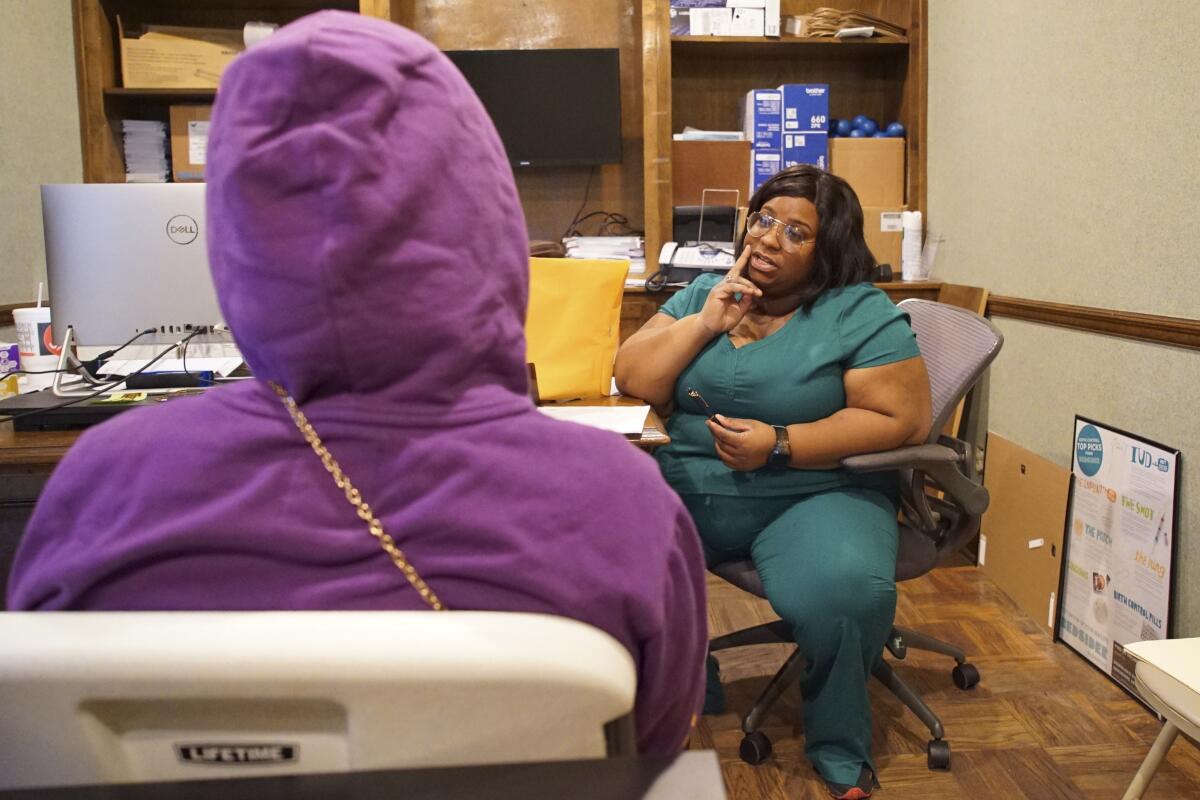
ATLANTA — The impact was immediate: The moment the Supreme Court struck down Roe vs. Wade, Robin Marty, operations director of the West Alabama Women’s Center in Tuscaloosa, told nurses, desk staff and a doctor that they could no longer provide abortions.
“I can’t believe they [expletive] did it,” she said via phone Friday. “You have to stop now!”
Just as Roe was a landmark case for women’s rights in 1973, its reversal Friday is a resounding, if expected, ruling that will again reshape abortion in this volatile and divided nation. It left millions of women in conservative states wondering what their options are.
Marty’s clinic staff told more than 20 patients in the waiting room that they could continue their ultrasounds and counseling, but could not have abortions. About 100 other patients would later be called to
cancel appointments and receive referrals to a clinic about 200 miles away in Atlanta, where the procedure is still legal.
But the Atlanta clinics may not remain open much longer. Georgia lawmakers passed a strict law in 2019 outlawing most abortions once fetal cardiac activity is detected, typically at around six weeks of pregnancy. The law was blocked by the courts but is now likely to take effect this summer.
The Future of Abortion
This is one in a series of occasional stories about the state of abortion as Roe vs. Wade faces its most serious challenge.
Over the next few days, weeks and months, the logistics of accessing abortion care in the United States will get more cumbersome, complicated and chaotic, especially for women of color or with limited incomes. About 26 states are set to ban abortion, cutting off or severely restricting access to the procedure for more than 35 million women of reproductive age in vast swaths of the South, Southwest and Midwest.
“This is absolutely a historic setback — a major failure for all women across the United States,” said Diane Derzis, the owner of Mississippi’s last remaining abortion provider, Jackson Women’s Health Organization, the clinic at the center of the Supreme Court case.
By Friday afternoon, nine states were enforcing abortion “trigger” bans: Alabama, Arkansas, Kentucky, Louisiana, Missouri, Oklahoma, South Dakota, Texas and Utah.
“Providing an abortion is now illegal in all of them with very rare exceptions that vary by state,” said Elizabeth Nash, a state policy analyst for the Washington, D.C.-based Guttmacher Institute.
Planned Parenthood and independent clinics across Texas were forced to suddenly halt abortion services after Atty. Gen. Ken Paxton announced that the state would enforce old antiaboriton laws that were never repealed. “Abortion is illegal here,” Paxton said in a statement. “I look forward to defending the pro-life laws of Texas and the lives of all unborn children moving forward.”
In Alabama, Marty will probably have to direct patients — who already come from as far as Mississippi, Louisiana and Texas — to clinics farther away in Florida and North Carolina, Illinois and New York. She will also struggle to keep her clinic open to offer after-care to women who self-manage their abortions by taking pills at home.
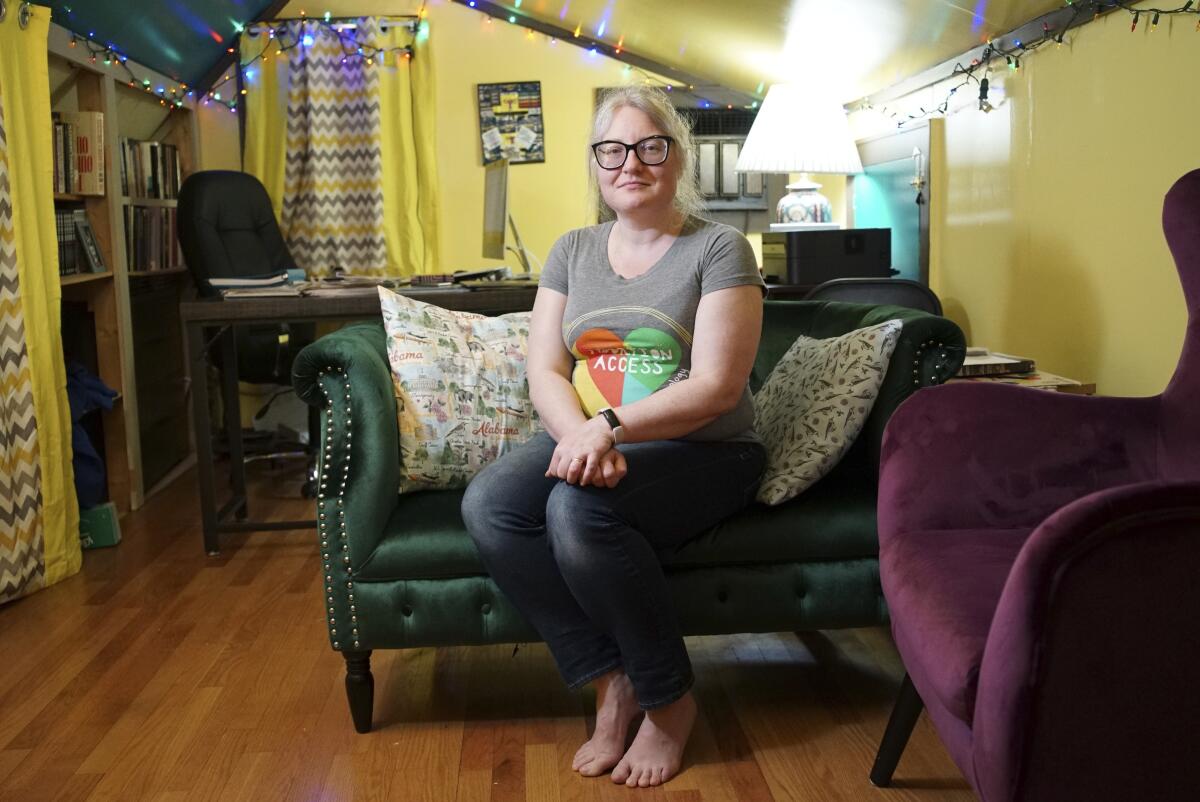
“This keeps me up at night, every night,” Marty said.
The timeline of when abortion could be outlawed varies from state to state, with women across the United States dependent on an often confusing patchwork of state laws and court rulings. What is essentially unfolding is a sprawling, untested workaround that will help women in half the country navigate abortions outside their restrictive states.
“This is just not a light switch,” said Nash, noting that Roe’s fall does not automatically establish a nationwide abortion ban. “I’m seeing a lot of chaos happening for a little while.”
In a historic reversal, the Supreme Court on Friday overturned the landmark 1973 Roe vs.
A total of 13 states have trigger bans, set to take effect automatically or by state action. An additional nine states, according to Guttmacher, have in place one or multiple types of abortion bans: resurrecting ones in place before Roe, a near-total ban enacted after Roe, a six-week or eight-week ban that is not in effect, or constitutions that specifically bar a right to abortion.
Four more Republican-led states — Florida, Indiana, Montana and Nebraska — have passed a raft of abortion restrictions in recent years and are likely to move swiftly, possibly through special sessions this summer, to pass abortion bans. This is happening at a time when the United States saw an unanticipated rise in abortions, jumping from 862,320 in 2017 to 930,160 in 2020, according to Guttmacher.
“There’s going to be a lot of confusion, particularly for patients — on the day of the decision and for weeks afterward,” said Melissa Fowler, chief program officer at the National Abortion Federation, which runs a national hotline and the largest abortion assistance fund in the nation.
While some clinics in red states will try to keep their doors open as long as they can, others had already stopped providing abortions or scheduling appointments for July in anticipation of the Supreme Court decision. Many plan to close or wind down operations if their state outlaws abortion.
Derzis, the owner of Mississippi’s only abortion clinic, is not sure about the future of that clinic, but plans to open another this month in Las Cruces, N.M., where there are no gestational limits on abortion.
With so many clinics in flux, the National Abortion Federation recently launched a members-only marketplace for clinics to buy and sell equipment and office supplies. They also match available doctors and other clinic staff with jobs, Fowler said, and have helped some get licensed so they can move to other states as clinics close.
The decision will also put pressure on President Biden to act to protect abortion rights.
However complicated the landscape of abortion becomes, abortion rights advocates stress that patients seeking to end their pregnancies will still be able to access services, including assistance from abortion rights groups that help women with plane and bus tickets to other states. But some abortion providers say they are already struggling to provide care to a massive influx of patients from Texas and Oklahoma after those states passed sweeping abortion restrictions.
In Wichita, Kan., the Trust Women clinic has doubled its patient days to four per week and plans to increase daily patient caps from 35 to 50. Still, it is booked through July, and every day more women, some from more than 500 miles away, call frantic for an appointment.
“We will not see everyone who needs care,” said Ashley Brink, director of the clinic. “We can’t.”
The Roe decision will not force the Wichita clinic to close its doors immediately: The Kansas Supreme Court ruled in 2019 that the state Constitution includes a right to bodily autonomy, protecting the right to abortion. But Republican lawmakers decided to put the issue to Kansas voters, who will decide in August on a constitutional amendment that would overturn that decision.
“This is a national emergency,” Brink said. “It’s about to come to a head.”
In Alabama, clinic managers decided to stop performing abortions as soon as the Supreme Court’s ruling was announced. The state has a pre-Roe ban, last amended in 1951, that forbids abortions in all cases except to preserve the life or health of the mother.
Here’s everything you need to know about the U.S. Supreme Court’s decision on Roe vs. Wade.
But across state lines in Georgia, providers say they do not expect to see abortion outlawed straightaway.
Lauren Frazier, director of communications for Planned Parenthood Southeast, which operates in Alabama, Georgia and Mississippi but provides abortions only in Georgia, said it could be weeks or months before Georgia’s ban is enforced.
“We certainly don’t have any intention of stopping care or changing any way that we provide our vital reproductive health services up until we know more,” she said.
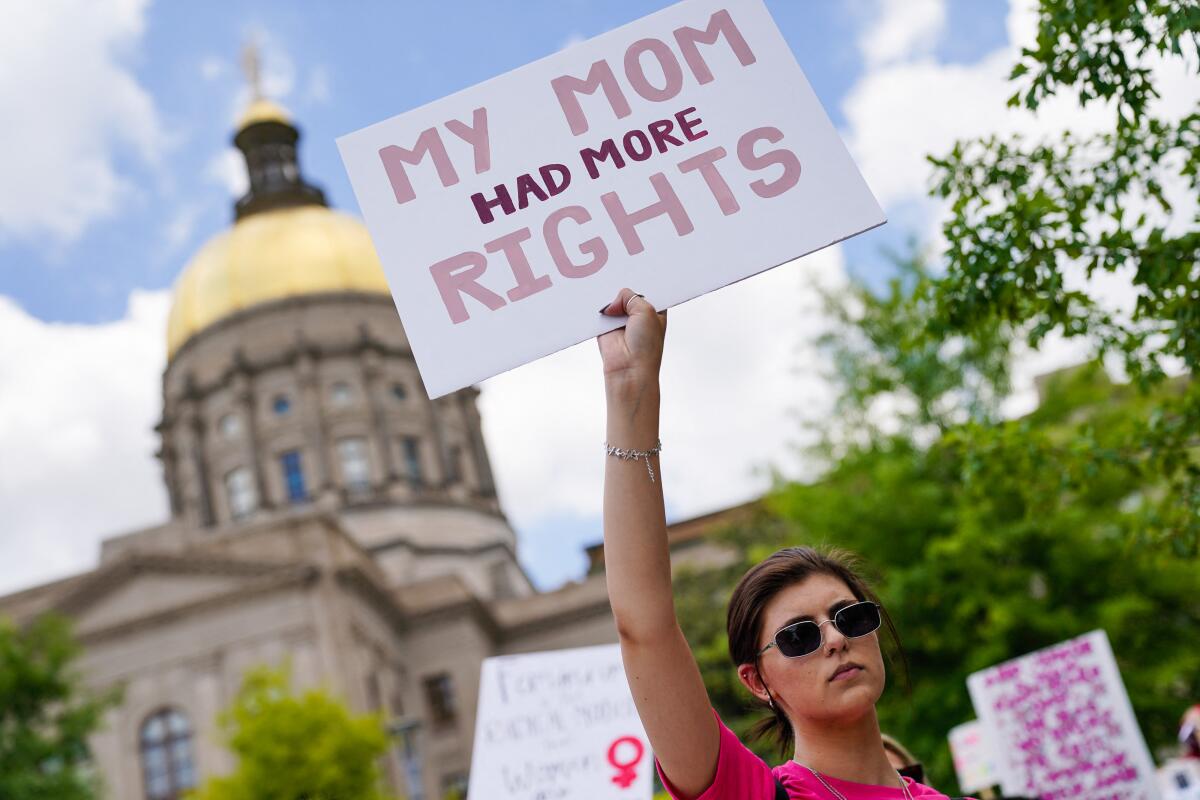
Even in Louisiana, a state that has a trigger ban, a near-total ban, a six-week ban and a state Constitution that bars protection, some providers said ahead of the ruling that they did not plan to close and would take legal advice after the ruling.
“We’re not giving up,” said Kathaleen Pittman, the clinic administrator at the Hope Medical Group for Women in Shreveport. “Do I intend to shut the doors and walk away? No, I do not. We would not leave everyone hanging.”
Still, Pittman, who has worked at the Shreveport clinic for nearly three decades and witnessed a wave of restrictive laws in red states force other abortion clinics to shut, said she could not stop worrying.
“Are we going back to the way it was when only the women who could afford it would fly out wherever they needed to go to get care?” she said. “Will we be back to women trying their very best to take matters into their own hands?”
Roe vs. Wade went from ‘settled’ law to overruled in a few years, thanks to four unexpected developments.
More women would wind up in emergency rooms, she feared. More women who could not afford children would be forced to continue pregnancies.
“Women in Louisiana deserve better,” she said. “I feel like Louisiana has reached a level of cruelty I never thought imaginable.”
While trigger bans take effect immediately in some states, they will go into effect in others on a staggered schedule, Nash said. Idaho and Tennessee have a 30-day waiting period, and some states require additional administrative steps, such as the governor or state attorney general certifying that the U.S. Supreme Court has overturned Roe, before abortion bans can take effect. “It would be a matter of days,” Nash said. “Some of it will be the day of.”
She added: “There’s a real potential here for clinics to simply close as soon as they hear about the decision because they want to make sure they’re not in violation of any law,” Nash said. “They want to hear from their attorneys what it means and from any state officials about how it’s going to be implemented.”
In states where abortion laws will take some sorting out in the courts, experts said it probably will be settled within months.
Ahead of an expected Supreme Court decision on Roe vs. Wade, medication abortions have surged — and drawn the interest of opposition groups.
Georgia and Ohio both banned abortion at six weeks gestation, but those bans were blocked by the courts. With Roe now overturned, Nash said, the attorney general will have to file a dismissal of the case or ask the judge to allow the ban to take effect.
“That might take a bit of time,” Nash said.
Clinic managers and abortion advocates in many red states say the burden of seeking abortion care will fall disproportionately on Black and brown women with few resources, many of whom already have children and struggle with child care or juggle multiple jobs or live in rural areas without transportation. Some patients do not have IDs. Others are disabled.
“It’s not just being able to hop over to another state,” Marty said, noting that about two-thirds of her patients live below the federal poverty line. “The reality is that most of the people in Alabama who come to us, they struggle just to get across the state to get care,” she said. “To take a week off to be able to travel to Chicago, that’s not something they’ll be able to do.”
While many national organizations are focused on opening clinics and bolstering abortion coverage in blue states, experts expect so-called haven states will find it increasingly difficult to absorb all those patients as more red states outlaw abortion.
Managers of independent clinics in red states caution that some of their clients will not be able to travel farther. For a rural patient in Alabama, Marty said, it would take several days to get to Birmingham to catch a connecting flight to Atlanta, then fly to Chicago, secure an abortion, and travel all the way back home.
“We know that those people are most likely going to try to manage their own care,” Marty said.
According to medical experts, women in the early phase of pregnancy can safely administer abortion at home using either a combination of two drugs, mifepristone and misoprostol, or misoprostol alone. But checkups from a health professional are recommended before and after.
A look back at U.S. abortion laws and the Roe vs. Wade decision.
Some antiabortion groups are expected to pressure state authorities to enforce local abortion restrictions — or work around liberal district attorneys to file civil lawsuits against those who fund abortions or offer practical support to women seeking abortions.
John Seago, legislative director for Texas Right to Life, said a pre-Roe statute in Texas that makes it illegal to “furnish the means for procuring an abortion” will have to be interpreted by courts.
“It at least means paying for an abortion,” Seago said. “The question is: Will the court uphold that pre-Roe statute if you challenge one of these abortion funds?”
Antiabortion groups have also been working to block the widespread distribution of abortion medication through the mail, but that’s trickier, said Kimberlyn Schwartz, a Texas Right to Life spokesperson. Though Texas passed a law last year restricting abortion medication, it’s not clear how effective it’s been.
“We haven’t nailed down one approach to stop that,” she said.
Mary Ziegler, a professor of law at UC Davis, said enforcement will not be easy in red states: “There’s going to be a kind of arms race, where states are trying to close loopholes in existing laws and using potentially draconian methods to do that, and then other people are trying to evade whatever states are doing,” Ziegler said. “That kind of back-and-forth can be pretty unpredictable.”
Marty aims to keep her small clinic in Tuscaloosa open to provide post-abortion care for women who manage their own abortions, travel to other states or have miscarriages and are afraid to go to a hospital. Supporting independent clinics in red states, she said, is just as important as building new clinics in blue states.
“We need to keep independent providers open in the South, even if they’re not providing abortion,” she said. “Because that is going to be the only safe place for most of the population to go.”
More to Read
Sign up for Essential California
The most important California stories and recommendations in your inbox every morning.
You may occasionally receive promotional content from the Los Angeles Times.
